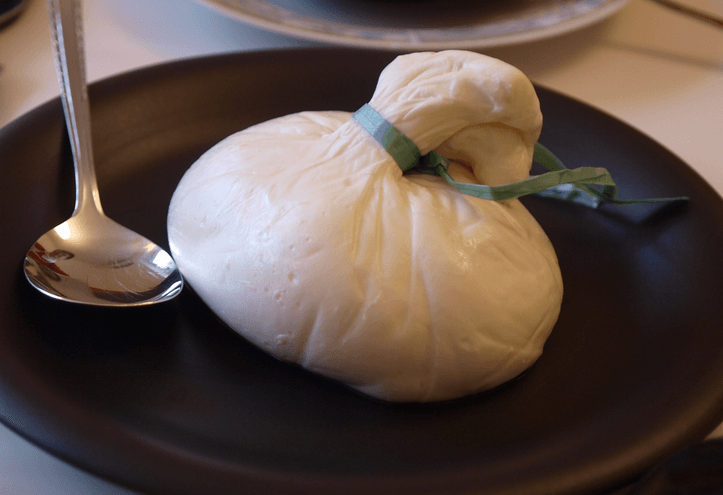Why Brooklyn Is Bonkers for Burrata


There’s cheese hiding in that there cheese.
You’ve doubtless seen it offered on every third Brooklyn menu (or every other menu in Manhattan), listed amongst the beet salads, roasted octopus tentacles, oysters spritzed with yuzu and chicken liver mousse crostini. We’re talking about burrata; generally adorned with aged balsamic and fruity olive oil and served with juicy tomatoes, but occasionally gussied up with anything from walnuts, roasted squash and buckwheat, to cold lobster, fermented broccolini and lemon-pane grattato. But what, precisely, is burrata, and how has it managed to work the restaurant industry up into such a profound lather?
A fresh Italian cheese, burrata was believed to have originated in Puglia back in the 1920s, as a way for factories to use up leftover scraps of mozzarella. The process begins by plunging fresh cheese curds into hot whey or salted water, and stretching and shaping them into a pouch, which gets stuffed to bursting with more milky shreds of tender mozzarella, that have been liberally doused with cream. The result is, that when the delicate outer layer is pierced, a torrent of unctuous dairy deliciousness oozes right out into your plate, perfect for sopping up with fat ribbons of pasta, sturdy leaves of spinach or frisee salad, salty lengths of prosciutto, or slabs of crusty, toasted bread. “People LOVE food inside of food, and people really love cheese. And burrata is cheese inside of cheese,” explains former Northeast Kingdom Kevin Adey, who has already added burrata (paired with pumpkin, red cress and shitakes) to the opening menu of his upcoming Bushwick eatery, Faro. “It’s like the holy grail of food inside of food.”
And while burrata mania is currently at peak, the Polly Pocket of cheese has long been a staple item at restaurants like Anella in Greenpoint, where it’s served in its own crock topped with a sprinkle of basil-infused salt, and a scoop of star anise-scented tomato jam. “I actually took it off the menu three months ago, and my guests almost mutinied,” laughs chef Todd Andrews. “Now, when I run it as a special, it’s gone in a matter of hours. Customers tell me that they’d gladly line up at the door for it!” So considering the frenzy surrounding burrata, it’s no wonder that it tends to fetch quite a premium, whether added to a dish of fire roasted peppers for a $4 surcharge at Barboncino (actually a steal, as far as burrata is concerned), or commanding a whopping $35 on the high-end of the spectrum, paired with foraged wild Oregon morels at the Tribeca wine bar, Racines.
Which is why, for the sake of your wallet, it’s probably best to go to the source as often as possible, by ordering baggies of burrata without the bells and whistles at local cheesemongers, or at specialty food stores. “I feel like we had this conversation a few years back about buffalo mozzarella, but now that you mention it, we have been selling a lot more burrata lately at A.L.C Italian Grocery,” confirms owner Louis Coluccio.
“My best guess as to the reason? Burrata has proved a good segway from traditional mozz, by being just different enough to get people excited, without being off the wall crazy,” he adds. “It also helps that it’s freaking delicious and there are lots of great local producers making fresh product nowadays; Vermont creamery for one. Local production really helps keep the burrata fresh, which is of utmost importance.” Incidentally, A.L.C is also our primary source for curds when we feel like undertaking burrata ourselves. Which is not as often as you’d think, but a viable option when we want to impress our friends with our cheese-making prowess, beyond so-easy-a-small-child-could-do-it ricotta, that is.
So if you’d like to take a stab at the trending cheese yourself, check out this simple recipe we scored from Todd, which, at the very least, should save you from the clamoring, burrata-crazy crowds gathered outside of Anella’s door.
Handmade Burrata, courtesy of Anella’s Todd Andrews
(Makes 1 round of cheese)
6 ounces fresh mozzarella curd
1 cup cream
Cut the mozzarella curd in half, setting one half aside. Grate the other half with a cheese grater into a bowl and mix well with the cream until smooth and creamy and completely incorporated. Season to taste with salt and fresh cracked black pepper. When filling is done, put in fridge until ready to use and heat a pot of water to a boil. When water is boiling turn heat off, and wait five minutes. When water is just cool enough to be able to touch with bare hands, drop the remaining half of mozzarella into the water. After about five minutes remove with tongs, and press flat against your hand with the other hand. Take the mozzarella in both hands and stretch across one hand until even, and using an ice cream scoop, scoop a heaping amount of the filling into the center of the cheese. Stretch the cheese around the filling, pulling it toward the center of the filling until completely stuffed. Drizzle with olive oil.
You might also like 




















